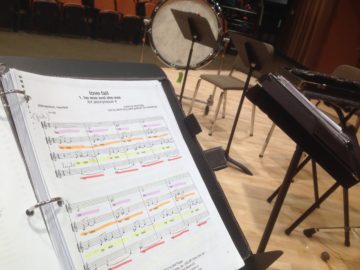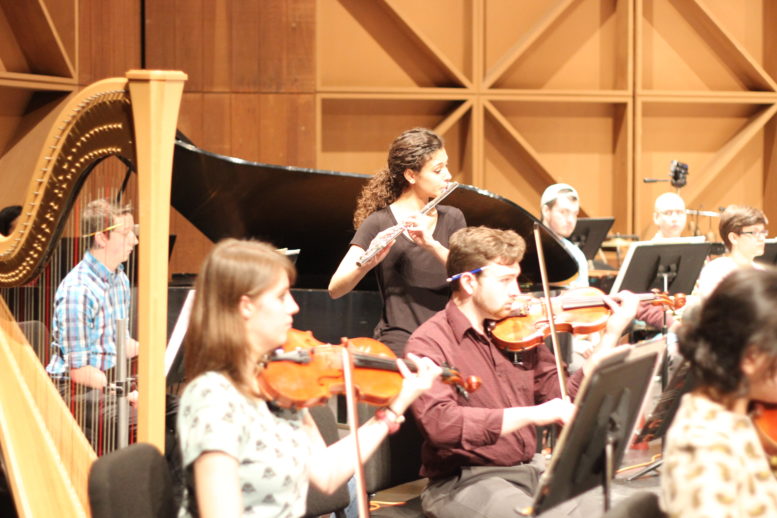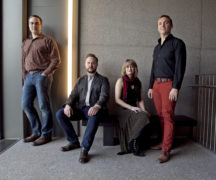By DAVID DUPONT
BG Independent News
When the New Music Gathering arrives at Bowling Green State University next May 11-13, it will be further confirmation that the College of Musical Arts has become a Midwestern center of contemporary music.
That reputation is grounded in the New Music Festival, which started in 1980 and staged every October. The university is also one of only two that offers a doctorate with a specialty in contemporary music. That gives it a foothold with the younger generation of performers, composers and impresarios
A series of performances by visiting and resident performers in the past week has demonstrated the extent to which contemporary music has been infused into the culture of the College of Musical Arts. A series of in-house concerts this week further elaborates on the theme.
This activity testifies to contemporary music’s place at center stage at BGSU.
The opening act for this un-festival was the biggest name, Roomful of Teeth. The voice ensemble arrived Wednesday as the guest artist for the Dorothy E. and DuWayne H. Hansen series.

Roomful of Teeth answers questions
The ensemble has won a Grammy, and its signature piece “Partita for 8 Voices,” composed by one of its members Caroline Shaw, won a Pulitzer. The ensemble was the epitome how the Hansens envisioned for the series. They want to bring inspirational artists to campus to share their skills and artistic philosophies with students and the broader community.
The ensemble worked with students on campus and made an appearance at Bowling Green High School, sharing the joy and immediacy of new music wherever they went.
At a master class for voice students, ensemble members were able to pinpoint spots where a student singer needed help, and then suggest simple techniques to address the issue with immediate results. I expect we’ll hear some of these songs in a few weeks during the Conrad Art Song Competition on April 8. All of the ensemble singers who traveled to Bowling Green – Shaw and founder and conductor Brad Wells were not able to make the residency – answered questions from students and faculty.
They offered advice about preparing for performances – as contradictory as one would expect from a group of individuals with different experience – and the necessity of solid theoretical grounding, on which there was unanimity. Learn to sight sing. They talked about life on the road and the intersection of early and new music, and why so many singers gravitate to both genres.
Then on Thursday night, they performed a free concert in Kobacker, which was as full as I’ve seen in years. They performed the Partita in the first half, and then in second half sang five pieces that demonstrated the range of global vocal techniques they command. “Cesca’s View” by Rinde Eckert (who visited Bowling Green last September) featured some amazing yodeling.
And this was just the start.
Saturday night was the 50th Annual Concerto Concert featuring the four winners of the Competition in Music Performance, held last December. And this being Bowling Green, three of the four pieces performed were written in the last 40 years.
Stephen Dubetz played Stephen Hartke’s Clarinet Concerto “Landscape in Blue,” a kaleidoscopic jazz-scape. This like the other three pieces on the program made full use of the colors of the orchestra.
On John Corigliano’s “The Pied Piper Fantasy,” played by flutist Michelle Whitmore, the orchestra got to portray a city of rats from the folk tale. Whitmore was attracted to the piece because of its theatricality, and she played it to the hilt. She strode on stage dressed in a cap and cape during the opening section of the fantasy. When she wasn’t playing, she looked intently in the distance as if listening to the orchestra to determine how she would respond. She played the first half of the piece ending with “The War Cadenza,” a long flourish that put those scurrying rats in the drink.
Joan Tower’s Flute Concerto from 1989 is a more abstract work. But its complexities do not come without its charms. Kenneth Cox and the orchestra brought those to the fore. Especially notable was his interaction with the orchestra. At times the xylophone echoed his lines, and the bass trombone provided a ringing bottom to the ensemble.
The concert concluded with the oldest piece, Maurice Ravel’s Piano Concerto for the left hand performed by Peisi Luo. How many orchestral concerts have a piece from 1930 as the oldest piece? From the opening contrabass bassoon solo, the orchestration is a marvel, and certainly an influence on all the earlier pieces on the program.
Luo was forceful at the piece’s center. Driving across the keyboard, generating the power to provide harmony and melody with a single hand. Her right hand grasped the end of the piano or the edge of the bench to gain the purchase needed to execute the complex solo line.
The one-movement piece includes a mocking military march section. Is this the composer’s sardonic commentary on war? Pianist Paul Wittgenstein, who lost his right arm in World War I, commissioned the concerto.
May the newer pieces on the program age this well.
There’s no denying the political intent of Frederic Rzewski’s “The North American Ballads.” The composer is explicit in his leftist politics. When he was the featured guest composer at the 2006 New Music Festival, instead of a composer’s talk, he read from his journals reflecting his opposition to the Iraq War while accompanying himself on piano.
The ballads were all tunes sung by union activists in the mines and cotton mills of the south in the early part of the 20th century.
As played Sunday by pianist Zach Nyce, a student in the contemporary music doctoral program, these pieces are fierce music shot through with great beauty and humor. Rzewski has an encyclopedic knowledge and command of American popular music. Here we have strains of gospel, refractions of the blues, jazz beats from several eras, protest anthems, sentimental ballads all filtered through an unsentimental modernist sensibility. This is music of people meant to be performed by a virtuoso.
Nyce, who also plays in a variety of genres, is the perfect pianist. Several of the pieces call for improvisation, Nyce executes these passages seamlessly. “Winnsboro Cotton Mill Blues” featured a wonderful improvisation that would have fit in a laid back jazz fusion jam.
The last movement, “The Housewife’s Lament,” concludes with a cadenza in which the pianist must “dust” the piano with two clothes. A comic bit that was played for music as well as chuckles.

Bryan Recital Hall stage set for Quince.
Then Monday, three students from the graduate program came back to campus with the Quince Contemporary Vocal Ensemble. The quartet got its start in Bowling Green when Amanda DeBoer Bartlett, Kayleigh Butcher and Liz Pearse, all studied with Jane Schoonmaker Rodgers seven or so years ago. Carrie Henneman Shaw is the fourth member of Quince.
They performed David Lang’s hour-long “Love fail.” The piece is a haunting, atmospheric retelling of the Tristan and Isolde story. Each voice is exposed, even when they weave together to produce resonant dissonances. Every line, even the stroke of the bass drum or blast from the conch shell, accentuates a sense of angst. The words in Lang’s pieces aren’t just text set to music, but are integral musical elements, repeated, overlapping, chanted. The piece carried listeners along on its journey.
Quince will perform a different program tonight (Tuesday, Feb. 28) in the recital hall of the University of Toledo Center for the Performing Arts. Tickets are $10.
New music will showcased throughout the week at free concerts at 8 p.m. in Bryan Recital Hall on campus. Performances are: tonight, a concert of performers in the doctoral program; Wednesday, a showcase of faculty composers’ works; and Thursday, a performance by the New Music Ensemble.
All this happens at a time as prospective doctoral students are visiting campus to see if this is where their future lies. It’s clear that the future of music is already here.





